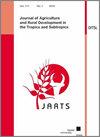畜牧生产高度脆弱地区初级生产的自然和土地利用驱动因素(乌拉圭埃斯特山脉)
Q3 Social Sciences
Journal of Agriculture and Rural Development in the Tropics and Subtropics
Pub Date : 2019-02-21
DOI:10.17170/KOBRA-20190219194
引用次数: 2
摘要
埃斯特山脉是乌拉圭最容易受到气候变化影响的两个地区之一。一个相关的脆弱性因子是天然草地生产力的变异性。本研究的目的是分析自然和土地利用驱动因素对草地生产力的作用,作为提高畜牧业生产适应能力和降低其对极端气候事件脆弱性的重要因素。利用地上净初级产量(ANPP)、降雨模式、土壤图和地表坡度、牲畜放养密度(LSD)信息以及对牲畜生产者的访谈,对2000-2015年进行了分析。结果表明:2000 ~ 2009年ANPP呈下降趋势,2010 ~ 2015年呈上升趋势;这些趋势与降雨波动有关:较大的ANPP变率可以用前4个月的降雨积累来解释。此外,ANPP还受土壤类型(越深越粘,ANPP越高)、地表坡度(越陡,ANPP越低)和LSD (LSD越高,ANPP越高)的影响。在干旱时期,这种关系被颠倒了。主要结果表明,干湿期ANPP的变化与所分析的驱动因素不呈线性相关,且存在重要的空间结构模式。这些证据为预测极端事件提供了信息,使人们能够确定和探索减少干旱影响的策略。脆弱性的降低意味着在个人层面提高牲畜管理效率的挑战,以及在集体层面整合和有利地补充该地区各种土地利用活动的挑战。从这个意义上说,公共政策应该在促进这些转变方面发挥主导作用。本文章由计算机程序翻译,如有差异,请以英文原文为准。
Natural and land-use drivers of primary production in a highly vulnerable region of livestock production (Sierras del Este – Uruguay)
Sierras del Este is one of the two regions in Uruguay that are most vulnerable to climate change. A relevant vulnerability factor is the variability of the natural grasslands’ productivity. The objective of this study was to analyse the role of natural and land use drivers on grassland productivity as an essential factor for increasing the adaptive capacity of livestock production and reducing their vulnerability to extreme climatic events. The period 2000–2015 was analysed using the aboveground net primary production (ANPP), rainfall patterns, soil maps and surface slopes, livestock stocking density (LSD) information, and interviews with livestock producers. The results showed a decreasing trend in ANPP between 2000 and 2009, and an increase between 2010 and 2015. These trends are associated with rainfall fluctuations: greater ANPP variability is explained by the rainfall accumulation of the 4 previous months. In addition, ANPP is affected by soil type (deeper and more clayey, higher ANPP), surface slope (steeper surface slope, lower ANPP) and LSD (higher LSD, higher ANPP). In drought periods, these relations are reversed. The main results suggested that changes in ANPP between drought and wet periods are not linearly related to the drivers analysed, and an important spatially structured pattern was detected. The evidence provides information to anticipate extreme events, allowing to define and explore strategies to reduce the impacts of drought. The reduction of vulnerability implies challenges at the individual level to increase efficiency in livestock management and at a collective level to integrate and complement favourably the various land use activities in the area. In this sense, public policy should have a leading role to promote these transformations.
求助全文
通过发布文献求助,成功后即可免费获取论文全文。
去求助
来源期刊
CiteScore
2.30
自引率
0.00%
发文量
0
审稿时长
>36 weeks
期刊介绍:
The Journal of Agriculture and Rural Development in the Tropics and Subtropics publishes papers dealing with original research and review papers in the fields of plant production, animal nutrition and animal husbandry, soil science, rural economy and farm management, forestry and forest economy, veterinary hygiene and protection against epidemics.

 求助内容:
求助内容: 应助结果提醒方式:
应助结果提醒方式:


